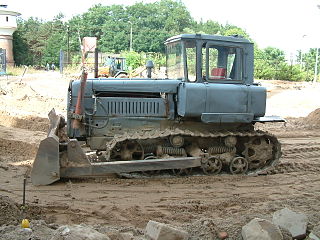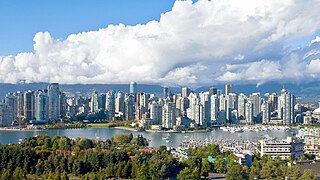
An architect is a person who plans, designs, and oversees the construction of buildings. To practice architecture means to provide services in connection with the design of buildings and the space within the site surrounding the buildings that have human occupancy or use as their principal purpose. Etymologically, the term architect derives from the Latinarchitectus, which derives from the Greek, i.e., chief builder.

Land use planning is the process of regulating the use of land by a central authority. Usually, this is done to promote more desirable social and environmental outcomes as well as a more efficient use of resources. More specifically, the goals of modern land use planning often include environmental conservation, restraint of urban sprawl, minimization of transport costs, prevention of land use conflicts, and a reduction in exposure to pollutants. In the pursuit of these goals, planners assume that regulating the use of land will change the patterns of human behavior, and that these changes are beneficial. The first assumption, that regulating land use changes the patterns of human behavior is widely accepted. However, the second assumption - that these changes are beneficial - is contested, and depends on the location and regulations being discussed.

William Zeckendorf Sr. was a prominent American real estate developer. Through his development company Webb and Knapp — for which he began working in 1938 and which he purchased in 1949 — he developed a significant portion of the New York City urban landscape. Architects I. M. Pei and Le Corbusier designed structures for Zeckendorf's development projects.
Real estate appraisal, property valuation or land valuation is the process of developing an opinion of value for real property. Real estate transactions often require appraisals because they occur infrequently and every property is unique, unlike corporate stocks, which are traded daily and are identical. The location also plays a key role in valuation. However, since property cannot change location, it is often the upgrades or improvements to the home that can change its value. Appraisal reports form the basis for mortgage loans, settling estates and divorces, taxation, and so on. Sometimes an appraisal report is used to establish a sale price for a property.
A bridge loan is a type of short-term loan, typically taken out for a period of 2 weeks to 3 years pending the arrangement of larger or longer-term financing. It is usually called a bridging loan in the United Kingdom, also known as a "caveat loan," and also known in some applications as a swing loan. In South African usage, the term bridging finance is more common, but is used in a more restricted sense than is common elsewhere.
A general contractor, main contractor, prime contractor, builder (UK/AUS), or contractor is responsible for the day-to-day oversight of a construction site, management of vendors and trades, and the communication of information to all involved parties throughout the course of a building project. In the USA a builder may be a sole proprietor managing a project and performing labor or carpentry work, have a small staff, or may be a very large company managing billion dollar projects. Some builders build new homes, some are remodelers, some are developers.

Subdivisions are the act of dividing land into pieces that are easier to sell or otherwise develop, usually via a plat. The former single piece as a whole is then known as a subdivision. Subdivisions may be simple, involving only a single seller and buyer, or complex, involving large tracts of land divided into many smaller parcels. If it is used for housing it is typically known as a housing subdivision or housing development, although some developers tend to call these areas communities.

Land development is the alteration of landscape in any number of ways such as:
Canada Lands Company Limited is a self-financing federal Crown corporation reporting to the Parliament of Canada through Public Services and Procurement Canada. The company is responsible for managing property on behalf of the federal government, conducting public consultation and integrating properties back into their surrounding communities for development. Most of its assets are located in Canadian urban centres, and are sold after the CLC revalued the property by providing managerial support and subsidizing immediate costs such as decontamination. However, the company retains ownership of some of Canada's most valued properties, such as Downsview Park, the CN Tower, the Old Port of Montreal and the Montreal Science Centre, from which it draws rental and hospitality revenues.

Mixed use is a type of urban development, urban design, urban planning and/or a zoning classification that blends multiple uses, such as residential, commercial, cultural, institutional, or entertainment, into one space, where those functions are to some degree physically and functionally integrated, and that provides pedestrian connections. Mixed-use development may be applied to a single building, a block or neighborhood, or in zoning policy across an entire city or other administrative unit. These projects may be completed by a private developer, (quasi-)governmental agency, or a combination thereof. A mixed-use development may be a new construction, reuse of an existing building or brownfield site, or a combination.
Farmland development rights in Suffolk County, New York began in 1975 in Suffolk County as the state of New York began a program to purchase development rights for farmland to insure they remained as farms and open space rather than being developed for housing.

Conservation development, also known as conservation design, is a controlled-growth land use development that adopts the principle for allowing limited sustainable development while protecting the area's natural environmental features in perpetuity, including preserving open space landscape and vista, protecting farmland or natural habitats for wildlife, and maintaining the character of rural communities. A conservation development is usually defined as a project that dedicates a minimum of 50 percent of the total development parcel as open space. The management and ownership of the land are often formed by the partnership between private land owners, land-use conservation organizations and local government. It is a growing trend in many parts of the country, particularly in the Western United States. In the Eastern United States, conservation design has been promoted by some state and local governments as a technique to help preserve water quality.
North Arm Cove is a suburb of the Mid-Coast Council local government area in the center of the Hunter and the southern extremity of the Mid North Coast regions of New South Wales, Australia. It is located adjacent to Port Stephens and extends well north of the Pacific Highway. The suburb is sparsely populated, with most of the residents living in the southern portion of the suburb.

Vancouverism is an urban planning and architectural phenomenon in Vancouver, British Columbia, Canada. It is characterized by a large residential population living in the city centre with mixed-use developments, typically with a medium-height, commercial base and narrow, high-rise residential towers, significant reliance on mass public transit, creation and maintenance of green park spaces, and preserving view corridors. The architect Bing Thom described Vancouverism this way:
It's a spirit about public space. I think Vancouverites are very, very proud that we built a city that really has a tremendous amount of space on the waterfront for people to recreate and to enjoy. At the same time, False Creek and Coal Harbour were previously industrial lands that were very polluted and desecrated. We've refreshed all of this with new development, and people have access to the water and the views. So, to me, it's this idea of having a lot people living very close together, mixing the uses. So, we have apartments on top of stores. In Surrey we have a university on top of a shopping centre. This mixing of uses reflects Vancouver in terms of our culture and how we live together.
René G. Lépine was a Canadian real estate developer and philanthropist. Lépine was the chairman of Groupe Lépine, a real estate development and investment firm he founded in 1953. He is widely considered one of the most influential French Canadian real estate developers of his time. His companies developed over $5 billion of real estate in Canada and the United States since the 1960s. He also owned a portfolio of multifamily and retail properties in Montreal and Ottawa. Lépine developed many buildings considered landmarks in Montreal, including the Olympic Village and Le Sanctuaire du Mont-Royal. Lépine is also credited with having developed the first condominiums in Montreal in 1981.

A site plan or a plot plan is a type of drawing used by architects, landscape architects, urban planners, and engineers which shows existing and proposed conditions for a given area, typically a parcel of land which is to be modified. Sites plan typically show buildings, roads, sidewalks and paths/trails, parking, drainage facilities, sanitary sewer lines, water lines, lighting, and landscaping and garden elements.
Graduate real estate education is the study of real estate development at the graduate school level. It has taken many forms, giving rise to various educational models in different countries.
Irvin J. Kahn (1916–1973) was an American attorney and real estate developer who played a major role in the expansion of the City of San Diego in the 1950s, 1960s, and 1970s. He received frequent press coverage for his ongoing role in developing Clairemont, University City and Rancho Peñasquitos. He is also notable for having built one of the first skyscrapers in downtown San Diego.
Jonathan Frederick Phinneas Rose is an American urban planner and real estate developer. Through his corporation Jonathan Rose Companies, he is known for developing communities that are considered affordable and environmentally-responsible. Apart from his involvement in various aspects of property, Rose has founded Gramavision Records, a jazz and New Music label. Rose has written several books including The Well Tempered City: What Modern Science, Ancient Civilizations and Human Behavior Teach Us About the Future of Urban Life.

The Platinum is a 17-story, 255-unit condo hotel located at 211 East Flamingo Road in Paradise, Nevada, east of the Las Vegas Strip. The project was approved in 2003, and began construction in 2005, as a joint venture between Diversified Real Estate Concepts, Inc. and Marcus Hotels and Resorts. The project was topped out in December 2005, and was opened in October 2006. In 2009, buyers filed lawsuits against Marcus for various allegations; the last of the lawsuits were settled in March 2013.












